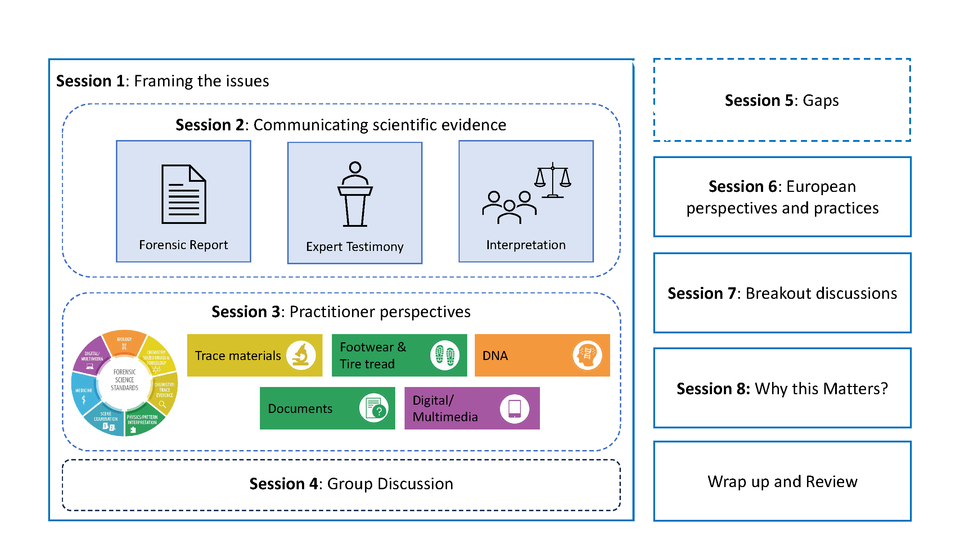NIST convened this workshop to examine how forensic findings are communicated in reports and testimony. The first day of the workshop explored how forensic findings are currently presented in the United States. From the presentations and discussions, we looked to examine the range of approaches currently in use or under development, with a focus on likelihood ratios and verbal scales; how comprehensible forensic findings are for end users, best practices for communicating scientific information to diverse audiences, and any knowledge gaps that may impact an end user’s understanding of the findings. On the second day, we heard from European colleague’s on how they approach forensic reporting and testimony and engaged in small group discussions to capture a variety of perspectives on how the forensic science community can improve communication of forensic findings. NIST plans to use the insights gained from the presentations and discussions to inform an upcoming Foundation Review. This event was intended for those actively engaged in communicating forensic findings, end users of the information being reported (e.g., legal community), and those who are working to improve the communication of scientific information with data analysis and research.

Presentations
Framing the Issues
Sandy Koch, NIST (SPO) – Current Practices and Future Directions
John Butler, NIST (SPO) – NIST Scientific Foundation Reviews
Judge J. Michael Ryan, DC Superior Court – Rule 702. Testimony by Expert Witnesses
Hal Stern, UC Irvine/CSAFE – Framing the Issues
Steve Lund/Hari Iyer, NIST (SED) – Framing Some Issues
Communicating Results in Forensic Reports and Testimony
Julie Burrill, Alan Alda Center for Science Communication – It’s not you, it’s me
Heidi Eldridge, George Washington University – Challenges in Communication Comprehension
Kristy Martire, University of New South Wales (Australia) – What is Successful Communication of Scientific Findings?
Clinton Hughes, Brooklyn Defender Services – Current Practices and Future Directions
Practitioner Perspectives (LR and OSAC Interpretation Scales)
Jarrah Kennedy, Kansas City PD Crime Lab, DNA – Communicating Forensic Biology Findings
Tatiana Trejos, West Virginia University, Trace Evidence – Trace Evidence Perspective on Interpretation Scales
David Kanaris, Alaska State Crime Lab, Footwear – Perspectives From The Footwear Practitioner Community
Lora Sims, Ideal Innovations, Digital & Multimedia – DM SAC Standard Guide for Image Comparison Opinions
Miriam Angel, Los Angeles PD, Documents – Forensic Document Examination
Gaps and How to Fill Them
Bill Thompson, UC Irvine/CSAFE – Gaps and How to Fill Them
Kate Philpott, Virginia Commonwealth University – Identifying Gaps & Limitations via SOPs
Dan Rabinowitz, Columbia University – Statistical Theory for Likelihood Ratios in Forensic Analysis
JD Schmid, 6th District Public Defender MN – Using A Validation Study Model To Minimize Wrongful Convictions
European Perspectives
Alex Biederman, University of Lausanne (Switzerland) – Guidance documents for evaluative reporting in forensic science: European developments
Anders Nordgaard, National Forensic Centre (Sweden) – When, how, and for whom?
Marjan Sjerps, Netherlands Forensic Institute (Netherlands) – Communicating LR conclusions in forensic reports
Why this Matters?
Lynn Garcia, Texas Forensic Science Commission – Why It Matters

